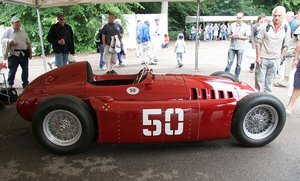Difference between revisions of "Ferrari D50 F1"
m |
m |
||
| Line 66: | Line 66: | ||
|Fastest laps || '''5''' | |Fastest laps || '''5''' | ||
|- | |- | ||
| − | | | + | | Video || Peter Collins winning the 1956 French Grand Prix at Reims in a Ferrari D50 F1 |
|- | |- | ||
| colspan=2 style="padding:0; background:#333333; color:#fff; border-bottom:1px solid #999;" |<center><videoflash>3feos79ieg0|280|200</videoflash> | | colspan=2 style="padding:0; background:#333333; color:#fff; border-bottom:1px solid #999;" |<center><videoflash>3feos79ieg0|280|200</videoflash> | ||
Latest revision as of 09:13, 6 November 2009
| Category | Formula One |
| F1 car | Y |
| Constructor | Lancia |
| Designer | Vittorio Jano |
| Team | Scuderia Lancia Scuderia Ferrari |
| Drivers | |
| Chassis | Tubular spaceframe, with stressed engine |
| Front suspension | Unequal length, tubular double wishbone, with transverse leaf spring and inboard dampers. |
| Rear suspension | De Dion tube, with transverse leaf spring and inboard dampers. |
| Wheelbase | 2280mm |
| Track | F: 1294mm R: 1330mm |
| Engine name | Lancia DS50 |
| Capacity | 2488cc-cu |
| Configuration | 90° V8. |
| Turbo/NA | Naturally aspirated, |
| Engine position | front-mounted. 1954: 260bhp. 1955/6: 285bhp. |
| Gearbox name | Lancia |
| Gears | 5-speed |
| Type | manual |
| Differential | transaxle |
| Weight | 620kg |
| Fuel | Shell |
| Tyres | Pirelli/Englebert |
| Debut | 1954 Spanish Grand Prix |
| Races | 14 |
| Wins | 5 |
| Cons champ | |
| Drivers champ | 1 (1956: Fangio) |
| Poles | 8 |
| Fastest laps | 5 |
| Video | Peter Collins winning the 1956 French Grand Prix at Reims in a Ferrari D50 F1 |
The Lancia D50 was a Formula One racing car designed by Vittorio Jano for Lancia in 1954. The car's design made use of many innovative features, such as the use of the engine as a stressed chassis member, the off-centre positioning of the engine to allow a lower overall height, and pannier fuel cells for better weight distribution and aerodynamics. Six of the cars were built, two of them are displayed in Italian museums.
The D50 made its race debut toward the end of the 1954 Formula One season in the hands of two-time and reigning World Champion, Italian driver Alberto Ascari. In its very first event Ascari took both pole position in qualifying and fastest race lap, although his car's clutch failed after only ten laps. Following Ascari's death, and in increasing financial trouble, the Lancia family sold their controlling share in the Lancia company, and the assets of Scuderia Lancia were given to Scuderia Ferrari. Ferrari continued to develop the car, although they removed many of Jano's most innovative designs, and the car was rebadged as the Lancia-Ferrari D50 and later simply the Ferrari D50. Juan Manuel Fangio won the Formula One World Championship in 1956 with this car modified by Ferrari. During their competition lifespan D50s were entered into 14 World Championship Formula One Grands Prix, winning five.
External links
| Ferrari Formula One cars | |||||||||||||||||||||||||||||||||||||||||
| 40s | 1950s | 1960s | 1970s | ||||||||||||||||||||||||||||||||||||||
| 8 | 9 | 0 | 1 | 2 | 3 | 4 | 5 | 6 | 7 | 8 | 9 | 0 | 1 | 2 | 3 | 4 | 5 | 6 | 7 | 8 | 9 | 0 | 1 | 2 | 3 | 4 | 5 | 6 | 7 | 8 | 9 | ||||||||||
| 125 | 275 340 375 |
500 | 553 625 |
555 D50 |
801 | 412 246 |
256 | 156 | 158 1512 |
312 | 312 B | 312 T | |||||||||||||||||||||||||||||
| 1980s | 1990s | 2000s | |||||||||||||||||||||||||||||||||||||||
| 0 | 1 | 2 | 3 | 4 | 5 | 6 | 7 | 8 | 9 | 0 | 1 | 2 | 3 | 4 | 5 | 6 | 7 | 8 | 9 | 0 | 1 | 2 | 3 | 4 | 5 | 6 | 7 | 8 | 9 | ||||||||||||
| 312 T | 126 C | 156/85 | F1/86 | F1/87 | 640 | 641 | 642/643 | F92A | F93A | 412T | F310/B | F300 | F399 | F1-2000 | F2001 | F2001 F2002 |
F2002B F2003-GA |
F2004 | F2004M F2005 |
248 | F2007 | ||||||||||||||||||||
